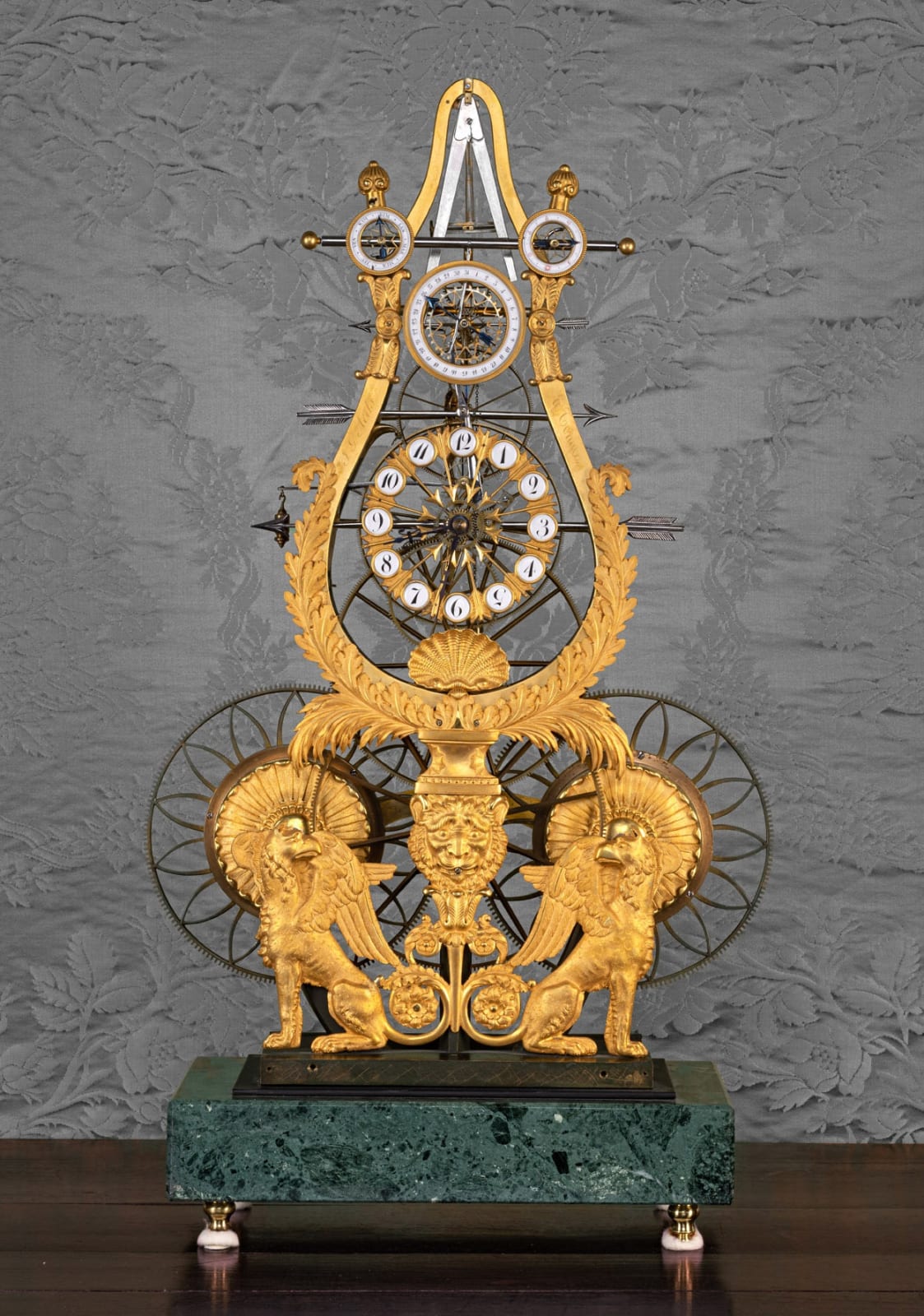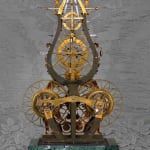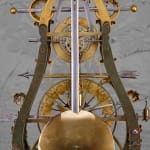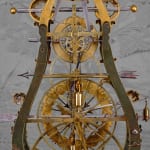
Derek Roberts, “Continental and American Skeleton Clocks”, 1990, p. 42, pls. 30a & b, illustrating and describing this skeleton clock by J. G. Aerts à Tongres (described as Aeits à Tongres).

F. B. Royer-Collard, “Skeleton Clocks”, 1977, pls. 7-11 – 7-13, illustrating this clock.

Skeleton Clocks, FB Royer-Collard, page 114.
Jean-Guillaume Aerts
Further images
Provenance
Provenance: Dr S. P. Lehv, New York, by 1977.
Literature
F. B. Royer-Collard, “Skeleton Clocks”, 1977, pls. 7-11 – 7-13, illustrating this clock.
Derek Roberts, “Continental and American Skeleton Clocks”, 1990, p. 42, pls. 30a & b, illustrating and describing this skeleton clock by J. G. Aerts à Tongres (described as Aeits à Tongres).
A very rare and fine late Empire gilt bronze and vert de mer marble multi-dial skeleton clock of year duration by Jean-Guillaume Aerts, signed on the uprights of the lyre-shaped frame J. G. Aerts à Tongres. The main dial with circular white enamel plaques with Arabic hour numerals interspersed by inward facing gilt arrows, with a pair of blued steel hands for the hours and minutes. Above the main dial is a white enamel calendar ring marked with the 31 days of the month with an arrow-shaped blue steel pointer. With two further subsidiary dial rings mounted on a cross pole at the top of the lyre-shaped frame, the one to the left with the abbreviated names of the days of the week and that to the right with their corresponding deity symbols, each with a blued steel arrow-shaped pointer. The movement with a Debaufe escapement and two skeletonised going barrels that are wound from the rear with both driving through beautifully pierced great wheels onto a single common central arbor, with all the wheelwork including the star wheel of great delicacy throughout the train, with each wheel being treated in a different manner. The imposing frame shaped as a lyre which encircles the main dial, with acanthus leaves around its lower half, centred by a scallop shell above palm fronds on an upright support shaped at the top as a vase upon a lion’s head above foliate scrolls and flanked either side by rosettes within the wheels, in front of which is a pair of griffins seated on a rectangular plate upon a later rectangular vert de mer marble base on turned feet
Tongres, Belgium, circa 1810
Height 52 cm, height with the base 62 cm, width 29.5 cm, depth 14 cm.
This is an exceptional skeleton clock that not only displays the ingenuity of the clockmaker but is also a work of art in its own right. An illustration of it in both Royer-Collard and Roberts’ books on skeleton clocks, shows that at one time it had an additional surmounting dial encircled by a snake, which unfortunately is now lost. Its maker was Jean-Guillaume (also referred to as Jan Willem) Aerts, who was the son of Willem Aerts (1746-1822) and Anna Elisabeth née Guldentops. He was born in Antwerp, Belgium on 11th June 1786 but spent most of his horological career firstly at Liège and then at Tongres, where he died on 3rd August 1864. Regarded as one of the best Belgian clockmakers of his day, he is assumed to have initially worked in the workshop of Hubert Sarton (1748-1828) – a famous clockmaker in Liège. Certainly that would fit in with Aerts’s career since following his marriage to Maria Catharina Isabella née Janssen (1788-1862), his first child named Fanny was born at Liège in September 1812. By the time of the birth of their next daughter Adélaïde, who was born in April 1814, the family had moved to Tongres, where his and Maria’s other seven children were all born.
In addition to this clock, another by Aerts is in the Museum of Longueville. Aerts contributed to the Expositions des Produits de l’Indutrie Nationale in Belgium, in both 1830 and 1841 Interestingly at the first he exhibited a pendule, forme de lyre, portée par le char du Soleil que conduit Apollon and then at the 1841 exhibition he showed three regulators, two of which were astronomical. In addition, another unusual skeleton clock with a lyre-shaped frame by Aerts signed on the base: Echappement Libre inventé et exècuté par J.G. Aerts de Tongres was offered by Sotheby’s Amsterdam on 12th December 2006, lot 179. The present clock was once owned by Dr S. P. Lehv of New York who had a fine collection of clocks, many of which were skeleton clocks.










